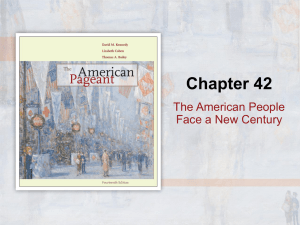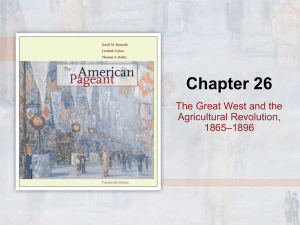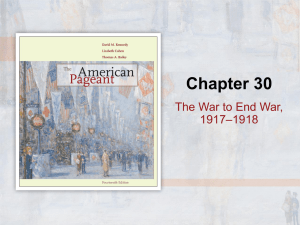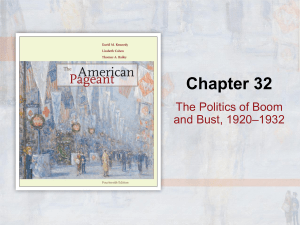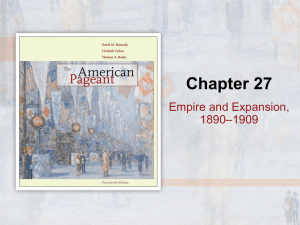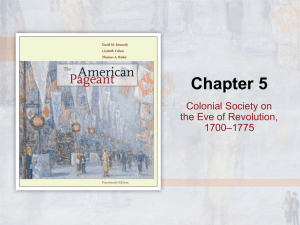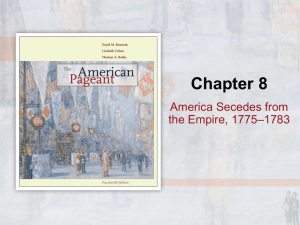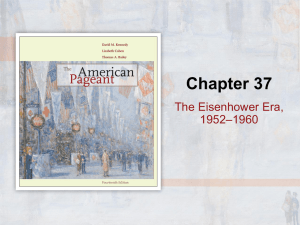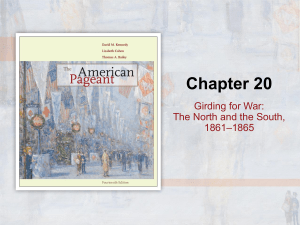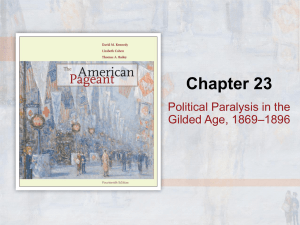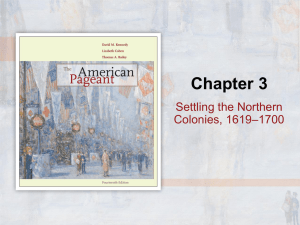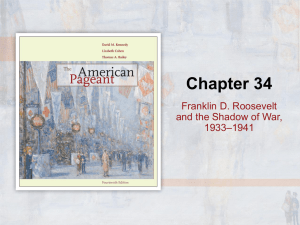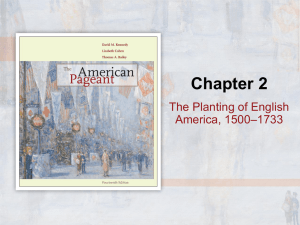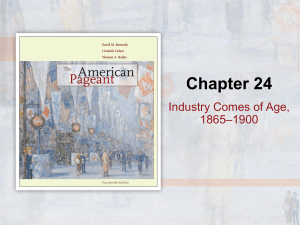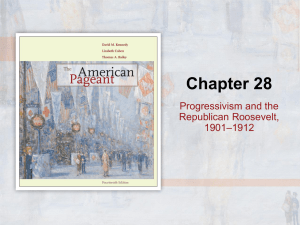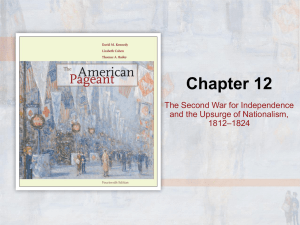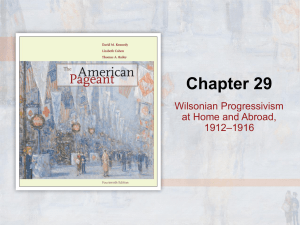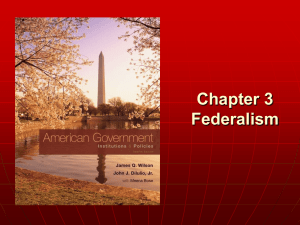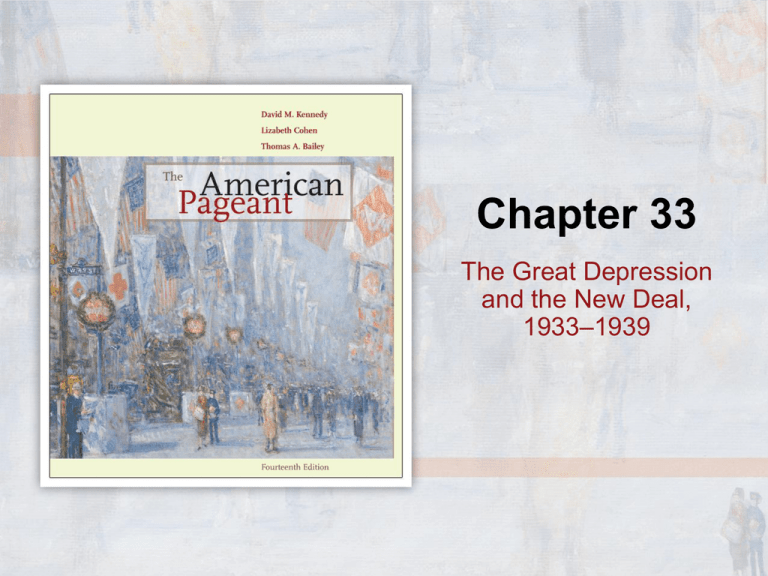
Chapter 33
The Great Depression
and the New Deal,
1933–1939
Question
Eleanor Roosevelt was known as the “conscience of the
New Deal” for all of the following reasons EXCEPT she
a) overcame the misery of an unhappy childhood and
emerged as a champion of the dispossessed.
b) traveled countless miles with FDR or on his behalf in
all his campaigns.
c) had worked in a New York settlement house, and
later on, she joined the Women’s Trade Union
League and the League of Women Voters.
d) brought an unprecedented number of women
activists with her to Washington.
Copyright © Cengage Learning. All rights reserved.
33 | 2
Answer
Eleanor Roosevelt was known as the “conscience of the
New Deal” for all of the following reasons EXCEPT she
a) overcame the misery of an unhappy childhood and
emerged as a champion of the dispossessed.
b) traveled countless miles with FDR or on his behalf in
all his campaigns. (correct)
c) had worked in a New York settlement house, and
later on, she joined the Women’s Trade Union
League and the League of Women Voters.
d) brought an unprecedented number of women
activists with her to Washington.
Hint: See page 824.
Copyright © Cengage Learning. All rights reserved.
33 | 3
Question
All of the following were true of the Brain Trust EXCEPT
a) they were a small group of reform-minded
intellectuals.
b) they were primarily associated with the banking
industry.
c) they were predominantly youngish college
professors.
d) as a kind of kitchen cabinet, they later authored
much of the New Deal legislation.
Copyright © Cengage Learning. All rights reserved.
33 | 4
Answer
All of the following were true of the Brain Trust EXCEPT
a) they were a small group of reform-minded
intellectuals.
b) they were primarily associated with the banking
industry. (correct)
c) they were predominantly youngish college
professors.
d) as a kind of kitchen cabinet, they later authored
much of the New Deal legislation.
Hint: See page 825.
Copyright © Cengage Learning. All rights reserved.
33 | 5
Question
Keynesianism was
a) heavy reliance primarily on the agricultural sector to
boost consumption and restore fiscal balance.
b) the use of tax cuts and monetary policy to boost the
economy through “trickle down” economics.
c) the use of government spending and fiscal policy to
“prime the pump” of the economy and encourage
consumer spending.
d) the use of key economic indicators to track the
effects of the prevailing laissez-faire approach to
governance.
Copyright © Cengage Learning. All rights reserved.
33 | 6
Answer
Keynesianism was
a) heavy reliance primarily on the agricultural sector to
boost consumption and restore fiscal balance.
b) the use of tax cuts and monetary policy to boost the
economy through “trickle down” economics.
c) the use of government spending and fiscal policy to
“prime the pump” of the economy and encourage
consumer spending. (correct)
d) the use of key economic indicators to track the
effects of the prevailing laissez-faire approach to
governance.
Hint: See page 846.
Copyright © Cengage Learning. All rights reserved.
33 | 7
Question
All of the following were true of the Civilian Conservation
Corps (CCC) EXCEPT
a) it proved to be perhaps the most popular of all the New Deal
“alphabetical agencies.”
b) it provided employment in fresh-air government camps for
about 3 million ex-criminals as part of a work-release
rehabilitation program.
c) their work was useful—including reforestation, firefighting
(forty-seven lost their lives), flood control, and swamp drainage.
d) the recruits were required to help their parents by sending
home most of their pay.
Copyright © Cengage Learning. All rights reserved.
33 | 8
Answer
All of the following were true of the Civilian Conservation
Corps (CCC) EXCEPT
a) it proved to be perhaps the most popular of all the New Deal
“alphabetical agencies.”
b) it provided employment in fresh-air government camps for
about 3 million ex-criminals as part of a work-release
rehabilitation program. (correct)
c) their work was useful—including reforestation, firefighting
(forty-seven lost their lives), flood control, and swamp drainage.
d) the recruits were required to help their parents by sending
home most of their pay.
Hint: See page 830.
Copyright © Cengage Learning. All rights reserved.
33 | 9
Question
All of the following were true of the National Recovery
Administration (NRA) EXCEPT
a) it was by far the most complex and far-reaching effort by the
New Dealers to combine immediate relief with long-range
recovery and reform.
b) it was designed to assist industry, labor, and the unemployed.
c) individual industries worked out “fair competition” codes to
reduce hours of labor so that employment could be spread over
more people.
d) a floor was placed on the maximum hours of labor; a ceiling
was placed above wages to establish
maximum levels.
Copyright © Cengage Learning. All rights reserved.
33 | 10
Answer
All of the following were true of the National Recovery
Administration (NRA) EXCEPT
a) it was by far the most complex and far-reaching effort by the
New Dealers to combine immediate relief with long-range
recovery and reform.
b) it was designed to assist industry, labor, and the unemployed.
c) individual industries worked out “fair competition” codes to
reduce hours of labor so that employment could be spread over
more people.
d) a floor was placed on the maximum hours of labor; a ceiling
was placed above wages to establish
maximum levels. (correct)
Hint: See page 835.
Copyright © Cengage Learning. All rights reserved.
33 | 11
Question
All of the following were true of the Agricultural Adjustment
Administration (AAA) EXCEPT
a) it rejected radical new approaches to
farm recovery.
b) through “artificial scarcity,” this agency was to
establish “parity prices” for basic commodities.
c) “parity” was the price set for a product that gave it
the same real value, in purchasing power, that it had
enjoyed during the period from 1909 to 1914.
d) the AAA would eliminate price-depressing surpluses
by paying growers to reduce their crop acreage.
Copyright © Cengage Learning. All rights reserved.
33 | 12
Answer
All of the following were true of the Agricultural Adjustment
Administration (AAA) EXCEPT
a) it rejected radical new approaches to
farm recovery. (correct)
b) through “artificial scarcity,” this agency was to
establish “parity prices” for basic commodities.
c) “parity” was the price set for a product that gave it
the same real value, in purchasing power, that it had
enjoyed during the period from 1909 to 1914.
d) the AAA would eliminate price-depressing surpluses
by paying growers to reduce their crop acreage.
Hint: See page 837.
Copyright © Cengage Learning. All rights reserved.
33 | 13
Question
All of the following were true of the Tennessee Valley
Authority (TVA) EXCEPT
a) this far-ranging enterprise was largely a result of the steadfast
vision and unflagging zeal of Senator George W. Norris of
Nebraska.
b) from the standpoint of “planned economy,” the TVA was by far
the most revolutionary of all the New Deal schemes.
c) this new agency aimed to discover how much the production
and distribution of electricity cost, so that a “yardstick” could be
set up to test the fairness of rates charged by private
companies.
d) the low cost of TVA power was due to dishonest bookkeeping
and the absence of taxes.
Copyright © Cengage Learning. All rights reserved.
33 | 14
Answer
All of the following were true of the Tennessee Valley
Authority (TVA) EXCEPT
a) this far-ranging enterprise was largely a result of the steadfast
vision and unflagging zeal of Senator George W. Norris of
Nebraska.
b) from the standpoint of “planned economy,” the TVA was by far
the most revolutionary of all the New Deal schemes.
c) this new agency aimed to discover how much the production
and distribution of electricity cost, so that a “yardstick” could be
set up to test the fairness of rates charged by private
companies.
d) the low cost of TVA power was due to dishonest bookkeeping
and the absence of taxes. (correct)
Hint: See page 839.
Copyright © Cengage Learning. All rights reserved.
33 | 15
Question
All of the following were true of the Social Security Act
EXCEPT
a) to cushion future depressions, the measure provided for
federal-state unemployment insurance.
b) to provide security for old age, specified categories of retired
workers were to receive regular payments from Washington.
c) payments ranged from $10 to $85 a month (raised periodically)
and were financed by a payroll tax
solely on employers.
d) provision was made for the blind, the physically handicapped,
delinquent children, and other dependents.
Copyright © Cengage Learning. All rights reserved.
33 | 16
Answer
All of the following were true of the Social Security Act
EXCEPT
a) to cushion future depressions, the measure provided for
federal-state unemployment insurance.
b) to provide security for old age, specified categories of retired
workers were to receive regular payments from Washington.
c) payments ranged from $10 to $85 a month (raised periodically)
and were financed by a payroll tax
solely on employers. (correct)
d) provision was made for the blind, the physically handicapped,
delinquent children, and other dependents.
Hint: See page 841.
Copyright © Cengage Learning. All rights reserved.
33 | 17
Question
All of the following were true of the Wagner Act
EXCEPT it
a) was also known as the National Labor
Relations Act.
b) destroyed the old National Labor Relations
Board.
c) was a major milestone for American workers.
d) was known as the Magna Carta of American
labor.
Copyright © Cengage Learning. All rights reserved.
33 | 18
Answer
All of the following were true of the Wagner Act
EXCEPT it
a) was also known as the National Labor
Relations Act.
b) destroyed the old National Labor Relations
Board. (correct)
c) was a major milestone for American workers.
d) was known as the Magna Carta of American
labor.
Hint: See page 841.
Copyright © Cengage Learning. All rights reserved.
33 | 19
Question
The Court Packing Plan involved
a) subtracting every conservative justice appointed since the
Wilson administration.
b) adding a new justice to the Supreme Court for every member
over seventy who would not retire.
c) dividing the justices into three camps—radicals, moderates,
and conservatives—and sending the conservatives packing.
d) multiplying the number of justices by the number of New Deal
agencies that they struck down, in order to create an incentive
to uphold New Deal legislation.
Copyright © Cengage Learning. All rights reserved.
33 | 20
Answer
The Court Packing Plan involved
a) subtracting every conservative justice appointed since the
Wilson administration.
b) adding a new justice to the Supreme Court for every member
over seventy who would not retire. (correct)
c) dividing the justices into three camps—radicals, moderates,
and conservatives—and sending the conservatives packing.
d) multiplying the number of justices by the number of New Deal
agencies that they struck down, in order to create an incentive
to uphold New Deal legislation.
Hint: See pages 845–846.
Copyright © Cengage Learning. All rights reserved.
33 | 21


